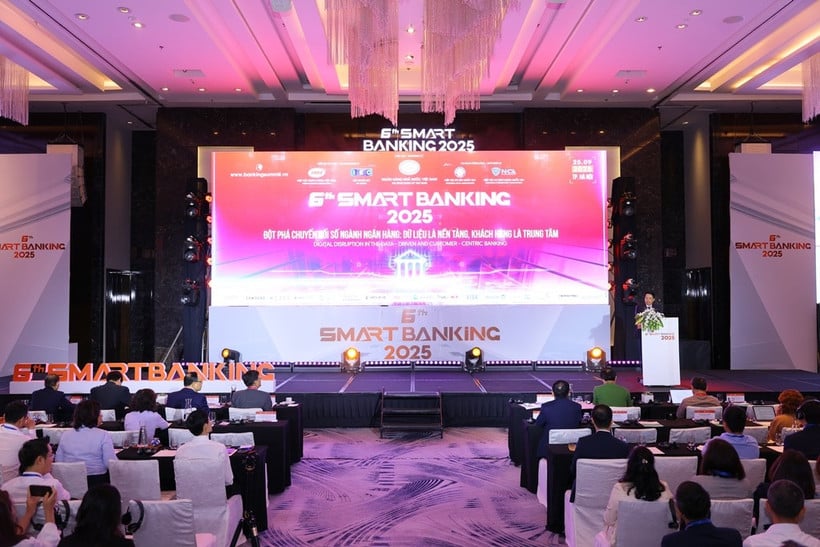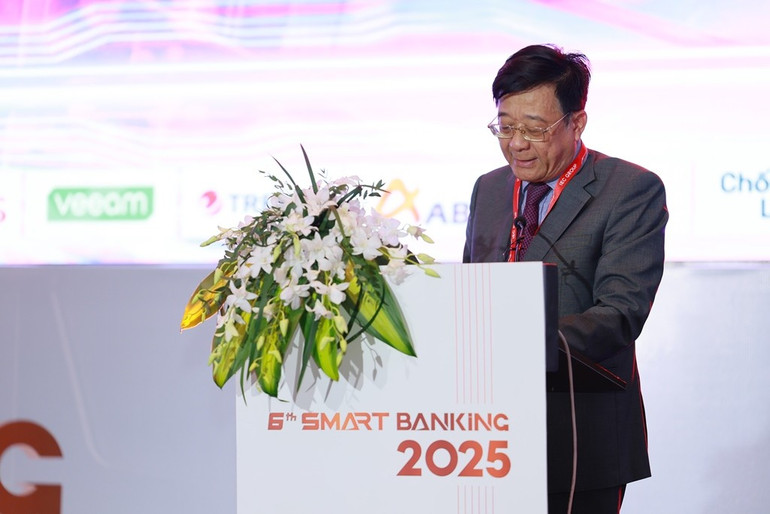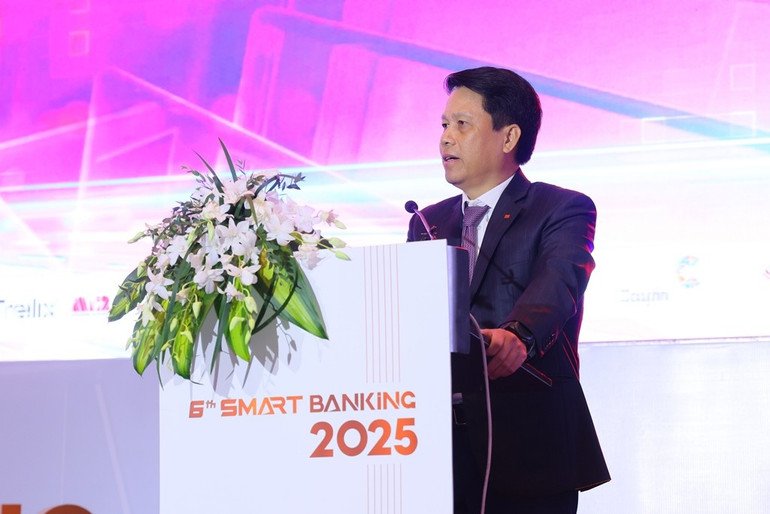
On September 25, in Hanoi , the annual high-level conference and exhibition of the banking industry - Smart Banking 2025 - officially took place with the theme "Breakthrough in digital transformation of the banking industry: Data is the foundation, customers are the center".
The event was organized under the auspices of the State Bank of Vietnam , coordinated by the Vietnam Banks Association (VNBA) and IEC Group, accompanied by the National Data Association and the National Cyber Security Association.
The banking industry is facing many challenges in effectively exploiting data sources: how to transform huge amounts of data into seamless, customer-centric experiences at every touchpoint; how to combine artificial intelligence (AI), big data analytics and new technologies to provide personalized services in real time, while still ensuring safety and security. This is not only a technological problem, but also a long-term strategy to turn data into a strategic asset, nurturing customer trust and engagement.
From “discrete data ownership” to “data governance as a strategic asset”
In his opening speech, Mr. Nguyen Quoc Hung, Vice Chairman and General Secretary of the Vietnam Banks Association (VNBA), said that many credit institutions have shifted from digitizing each process to redesigning the entire customer journey; from "owning discrete data" to "managing data as a strategic asset"; from passive reaction to forecasting and proactively suggesting needs.

According to the Vice President and General Secretary of VNBA, up to now, most basic banking services have been digitized on electronic channels; many banks have recorded over 95% of transactions conducted via digital channels instead of at traditional counters. The digital banking ecosystem is increasingly diverse and intelligent, bringing attractive utilities to customers, from money transfer, bill payment, savings to online loans... right on the phone.
Many basic operations have been 100% digitized (savings deposits, term deposits, opening and using payment accounts, opening bank cards, e-wallets, money transfers, loans...).
To date, nearly 87% of Vietnamese adults have bank accounts; the value of non-cash payments is 25 times the GDP. In the first 7 months of 2025 compared to the same period in 2024, non-cash transactions via QR codes increased by 66.73% in quantity and 159% in value.
Vietnam is also a pioneer in connecting cross-border retail payments via QR codes with Thailand, Cambodia and Laos, aiming to expand in the Asian region. In addition, the State Bank is the agency that has led the administrative reform rankings of ministries and ministerial-level agencies for 7 consecutive years.
Dr. Nguyen Quoc Hung pointed out that, to achieve real "breakthroughs" in 2025 and the following stages, it is necessary to simultaneously solve many intertwined problems: standardizing and cleaning data at the whole system scale; building a unified data architecture instead of overlapping solutions; establishing a consistent data governance-security-privacy-ethics framework. Strengthening the ability to interconnect controlled data between banks and identity platforms, population data, businesses, e-commerce, insurance, telecommunications; improving real-time analysis capacity to serve instant decision-making in credit granting, operational risk management and fraud monitoring.
"In order to provide banking products and services with high technology content and highly personalized services to enhance customer experience, data collection, exploitation and processing are always considered important," said Dr. Nguyen Quoc Hung.
According to Mr. Nguyen Quoc Hung, the rapid development of data-driven business strategies in the banking industry has created significant benefits. Specifically, banks can increase customer access, create highly personalized products and services, optimize risk detection and fraud prevention processes, improve loan processing and loan application processing, and enhance market prediction and analysis capabilities.
To date, many credit institutions have deployed solutions that allow customers to open payment accounts based on population data authentication; allow identification and verification of customer information using chip-based citizen identification cards or VNeID applications; clean customer information with the National Population Database; optimize the lending process with credit scoring solutions, multidimensional information authentication using population data, etc.
As of June 13, 2025, the banking industry has had more than 117 million customer records (CIFs) biometrically verified via chip-based citizen identification cards or VNeIDs (reaching nearly 100% of the total number of individual payment accounts generating transactions on digital channels); more than 927 thousand organizational customer records have had biometric information verified (reaching more than 70% of the total number of organizational payment accounts generating transactions on digital channels).
The National Credit Information Center (CIC) has coordinated with C06, Ministry of Public Security to complete 6 rounds of checking and cleaning customer data with about 57 million customer records offline.
63 credit institutions have deployed the application of chip-embedded citizen identification cards via counter devices; 57 credit institutions and 39 payment intermediaries have deployed the application of chip-embedded citizen identification cards via Mobile apps; 32 credit institutions and 15 payment intermediaries are deploying the VneID application.
Dr. Nguyen Quoc Hung emphasized the harmonious combination of: Strategy-Data-Technology-People, based on proactive risk management and compliance. From there, we aim for a sustainable digital banking ecosystem: innovative but safe, fast but standardized, personalized but protecting privacy, open connection but tightly controlling systemic risks.
The “Data is the foundation – Customer is the center” shift is not simply about deploying a few more technology systems. It is a shift in management thinking: from functional management to process management; from post-audit reporting to predictive analysis; from local measurement to overall optimization of customer lifetime value; from “collect as much data as possible” to “correct – clean – authorized – purposeful data – creating real value”.
The more data is used and shared, the more valuable it becomes.

Agreeing with Mr. Nguyen Quoc Hung on the collection and use of data, Deputy Governor Pham Tien Dung said that data and customers are independent, but in fact not separate. Without customers, there is no data; and data, if not used, has no value. This is the core story of the banking industry.
Legally, the State Bank is one of the few ministries and branches that issue a system of Circulars to regulate the entire process of data collection, synthesis, and analysis. In the banking industry, no data is collected outside this legal framework: from the statistical reporting system, credit information monitoring, CIC system, anti-money laundering, to all business applications, there are Circulars regulating, serving as a legal basis for the entire industry.
According to the Deputy Governor, in addition to the motto "correct-enough-clean-living", data must also solve two key problems, which are: First, exploiting data effectively; second, building good applications, integrating smart, useful and convenient for users.
Currently, the banking industry has deeply integrated with the National Population Database. The State Bank is also the first unit to issue a Circular on Open API, allowing parties to connect banking industry data.
The Deputy Governor emphasized that data is the foundation and a valuable resource. However, customers are the center. Therefore, in the current digital age, the banking industry must meet three factors, including: Creating good, smart applications for customers; effectively supporting customers; protecting the legitimate rights and interests of customers.
The Deputy Governor believes that the banking industry must provide truly good, smart, easy-to-use applications that quickly protect customers, while ensuring safety and convenience. Customer-centricity must be met from training, guidance to operation, everything must be smooth and seamless.
Deputy Governor Pham Tien Dung informed that the State Bank also builds a legal corridor to create conditions for banks to develop standard products and services, complying with international standards and norms to serve customers. This is an important foundation for the banking industry to develop operations in the digital space, promoting comprehensive finance.
“In just one day, the banking system recorded over 30 million transactions, with a total value of about VND900,000 billion (equivalent to about USD40 billion) in inter-branch transactions. This is an extremely large number,” the Deputy Governor added.
With such a huge number of transactions, Deputy Governor Pham Tien Dung said that ensuring banking security and maintaining safe and continuous operations is an important issue of concern for the banking industry.
Mr. Pham Anh Tuan, Director of the Payment Department, State Bank of Vietnam also said that the challenge of the banking industry is the lack of interconnectivity in data. "Data in databases and information systems is still fragmented, scattered, duplicated, and lacking connection and unity," Mr. Tuan said.
According to Mr. Pham Anh Tuan, in the strategic orientation for the period 2026-2030, the banking industry continues to upgrade and perfect the infrastructure for science, technology, innovation and digital transformation to ensure security and safety, focusing on building a common database system for the banking industry, moving towards making decisions based on data.
Continue to implement inter-sectoral coordination: integrate, connect, and share banking industry information with other industries and fields to expand the digital ecosystem and develop digital banking and digital payment services.

Dr. Can Van Luc, Chief Economist of BIDV, Member of the Prime Minister's Policy Advisory Council, also said: "Data has become the lifeblood of the economy and the financial sector, governing everything from investment strategy to risk management."
According to Mr. Can Van Luc, the value of data lies not only in the volume of data but also in its accuracy and quality. Accurate and relevant data ensures that financial institutions can make appropriate decisions and optimize operations.
"The success of applying artificial intelligence (AI) in particular and digital transformation in general depends on the source of data provided. Therefore, it is necessary to invest in building, standardizing, enriching, cleaning, and revitalizing data," said Mr. Luc.
Source: https://nhandan.vn/chuyen-doi-so-nganh-ngan-hang-can-quan-tri-du-lieu-nhu-mot-tai-san-chien-luoc-post910424.html


![[Photo] Prime Minister Pham Minh Chinh chaired a meeting of the Steering Committee on the arrangement of public service units under ministries, branches and localities.](https://vphoto.vietnam.vn/thumb/1200x675/vietnam/resource/IMAGE/2025/10/06/1759767137532_dsc-8743-jpg.webp)


![[Photo] Prime Minister Pham Minh Chinh chairs a meeting of the Government Standing Committee to remove obstacles for projects.](https://vphoto.vietnam.vn/thumb/1200x675/vietnam/resource/IMAGE/2025/10/06/1759768638313_dsc-9023-jpg.webp)


























































































Comment (0)